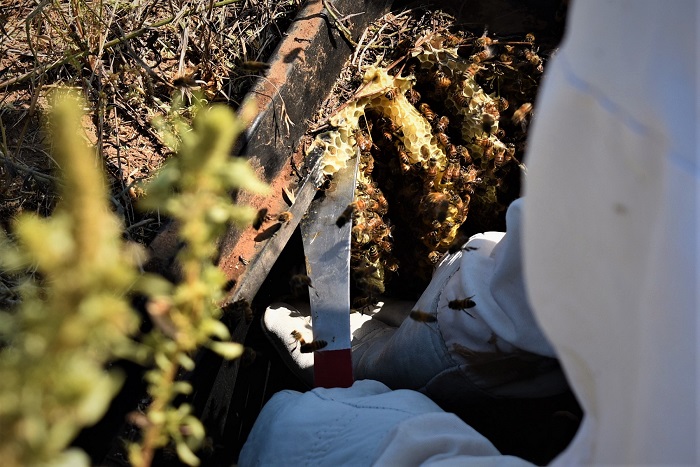“
They are lovely critters. They are far smarter than we are.
“
Jon Shipp
Spur Apiary
FLOYDADA — “On second thought, floral-print may not have been the best attire to wear out here.” That idea ran through my mind as a bee tried to crawl in a gap between the buttons of my Hawaiian shirt Monday morning. The bee attempted that invasion of privacy as I stood by a water spigot on a property just south of Floydada. The spigot, covered by an industrial green plastic lid, had recently become home to a beehive. It was now time for the bees to go. Beekeeper Jon Shipp of Spur was called in to remove the bees, and I was invited to watch the process. As a journalist I like to take my camera with me wherever I go. I assumed with a short-range telephoto lens I would be able to get some fairly decent shots of the removal. Somehow instead I was volunteered to suit up and join Jon for the process, camera in thickly-gloved hand.
PHOTO GALLERY: Floydada Beehive Extraction
Jon is an unassuming Londoner with a cutting wit that made the experience that much richer. He retired to Spur and picked up beekeeping as a hobby. “I wanted to keep my body and my mind active. I had worked with bees back in the UK. It was a case of ‘well, why not?'” After a few calls for help, a business was born. He is one of only a few people in the South Plains that has a state permit to carry bees over county lines, covers Dickens and the 8 surrounding counties as well as the Lubbock area.
Jon is the kind of man who can carry on a conversation with bees flying all around him. As we suit up he tells me it should be a very straight forward extraction, reminding me to keep my gloves on and to not get in the way. Not his… the bees. “Bees are gentle, they’re not going to be too aggressive; just don’t stand in their flight path,” he says putting on a hoodie with a beekeepers bonnet on top of it as he hands me a mesh suit that looks like it could double as a fencing lamé. “From a bee’s point of view they’ll collect the natural pollen and head straight into the hole, which is what they mean by making a bee-line back.” He explains that bees can go out two miles in any direction from the hive in search for food. Meaning a two mile radius becomes a 12 square mile area for one colony. “They can go a hell of a long way,” Jon says matter-of-factly.
As for why the bees were on the property, Jon says they likely traveled from nearby farms where bees are used to help crops pollinate. Just how far is what is most impressive “They could have traveled anywhere from an 8-10 mile area,” he estimates, adding that when a colony gets too big they will split. “The new colony will develop a new queen,” he explains over the buzzing of thousands of bees.
This is when the realization of what is happening is lost in the moment. During this part of our conversation Jon was working on the initial extraction of the hive while I was dutifully listening to him and taking photos. I was recording this part of our conversation for the quotes now being used in this article. On playback the sound of thousands of bees showing their displeasure at being disturbed is much more disconcerting than it was in the moment, a true testament to Jon’s calm nature.
Calm is a word he uses again to describe the bees themselves. “They are calm… right now it is really only ‘nurse’ bees, as the foragers are all out collecting food. The problems for people and property comes at night, when the other 80 percent of them come home.” That ‘problem’ is how we tend to react to bees — by swatting them away, or running. “They can fly faster than you can run,” he reminds me. But, he does have a suggestion if you find yourself dealing with bees chasing you. “Try to get into a dark space. They don’t like the dark, so if you can get into a shaded area, they will generally leave you alone.”
His perspective is that bees are a ‘live and let live’ type species. “A big swarm can be the size of an RV. They have no interest in you, you’re just in the way,” adding you can actually experience standing in a swarm if you don’t play around. “If you have a swarm they have no home to protect so you can put your hand in the middle and unless you crush a bee in your hand you won’t get stung.” Still, most people would pass on that opportunity, and Jon understands that. Simply put, he says people just don’t like bees. But he is working on that. “From my point of view it comes down to the more I can educate people, the better. I enjoy doing it. If people aren’t so scared, that’s great!”
At this point in the process Jon is holding up a honeycomb the size of an adult shoe. He is about to cut it up to transfer the comb to its new home inside a specially-designed box called a ‘super’ that you see on the edges of fields. Once the honeycomb is shaped onto wooden frames, it is secured in place with rubber bands. “They’ll actually chew through the rubber bands and form out the colony. It holds it upright so the honey won’t fall out the comb.” Speaking of honey, Jon was proud to point out to me the different parts of the comb — honey on the top, filled-in sections of white that house larvae known as the brood, and yellow bits of pollen scattered throughout.
When asked if he was able to secure the queen, something a number of people said had to be done to remove a hive, Jon said it isn’t as large of a requirement as once thought. “Purely it’s a matter of practicality. Taking the time to find her isn’t always worth the effort. It’s possible to just buy queens. If they’ve got eggs that are less than 3 days old so the bees themselves can convert one of their own into a queen. they can feed her royal jelly for the whole of her larvae stage.”
The main process of loading the bees into their box takes roughly 30 minutes, during that time Jon explains his frank philosophy on his line of work. “Beekeeping is one of those stupid things where everyone tries to make it mythical, and how difficult it is, but it’s not,” Jon says candidly. “It just takes common sense. Yes you need to know bee biology to a small degree, but it’s just a matter of move slowly and have two brain cells.”
We wrap up the extraction with an explanation on where bees can get… and why. Jon says they show up in “Farms, old buildings, anywhere that has a gap the size of a pencil eraser where they can get inside to breed.” The tendency of keeping bees from old buildings is going to take more than just patching up a hole, however. “Bees don’t fly around things. If I put a barrier, they won’t go around, they’ll go up and over. Their GPS is by location, and by location height is irrelevant.”
Now out of our suits and back at Jon’s truck, bees continue to buzz by us. Jon is unfazed and has taught me to act the same, giving me a newfound respect for what I once considered a pest. “They are lovely critters. They are far smarter than we are,” he laughs as I stare at another bee inspecting the flowers on my shirt.
If you have a bee problem and need his services, Jon can be contacted at Spur Apiary on Facebook or at (806) 271-4824.





